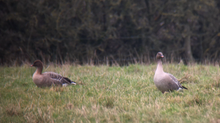Sustainable leather
If you have beef to eat, you have a hide from that animal - the two items are inseparable. We all know lots about local meat, have heard debates about what sustainable or even regenerative meat might be, and how we might buy meat that is traceable right back to the farmer. But so far this just hasn't happened with hides and the resulting leather. That verifiable connection back to farm and animal is not currently available.
One reason is that up until 4 or 5 years ago, the wholesale prices abattoirs got for their hides was good. It represented a useful income and hide collectors (fellmongers) would collect each day to ensure that they didnt spoil and were rapidly salted. No one particularly needed to add value and no one was asking for traceable leather.
Then the price the abattoir received reduced, due to reducing demand, geo political issues, animal health issues which stopped imports to China. England lost nearly all its tanneries years ago so most are exported to countries with lower wages and lower environmental laws, and the resulted finished products imported back to us. With minimal domestic infrastructure we are reliant on turbulent world markets. Then last year things hit (beyond) rock bottom as supply chains stopped and started and recessions have hit. Some abattoirs are now paid nothing for hides and some have to pay to have them disposed of. Only the really big abattoirs can command any money. A crazy situation.
But back to the point - if the cow the hide has come from is Pasture for Life certified, if the farm has a great story to tell, than that applies equally to the leather. Also the garment industry is currently under the spot light for its environmental practises, so interest was starting from a few enlightened companies.
So in the summer of 2020 a plan was hatched. Alice a fashion designer and Sarah who had worked with farmer groups in the USA approached the Pasture Fed Livestock Association about how PFLA hides could be collected and turned into ethical, sustainable leather with full traceability. As I had got the odd hide contract tanned in the past and sold it as belts, I was put in touch with them, and offered to collect specific hides from the abattoir. This involved 6 farmers from the Cotswolds (all PFLA) members suppling details of what cattle were due to be processed and me collecting the right hides on the right days. I then salted them all and tagged them with their original ID.
Last week Alice and Sarah visited the farm and used combinations of stamps to mark each hide in 4 places, so that each is coded and post tanning we can match the hide to the identity of the animal.
Then on Thursday I set off to Thomas Ware and Sons in central Bristol to deliver 30 of these special hides. This was the farthest I had driven for months and made a bitterly cold Thursday morning quite interesting! Thomas Ware's is one of only 3 remaining pit tanneries left in the UK. It's an amazing collection of victorian buildings perched above the Avon on Coronation Road. The process is relatively unchanged in 150 years and they are renown for production very high quality equestrian leather, and also sports ball leathers including cricket ball leather used at the highest sporting levels.
So the hides are now in their hands and will be for 3 months. They only use vegetable based products for tanning, and so their part of the process will have high environmental credentials. I am hoping to have several of my hides back for my own belt production, so I'm very excited to be involved with this great project.
Check out this great video of Thomas Ware's amazing tannery
For more info about the project the Sustainable Food Trusts article here

Thomas Ware & Sons Bristol

30 hides ready to leave Waterhay Farm

Coding each hide with stamps to keep the identity right through the tanning process


































Comments